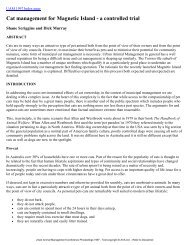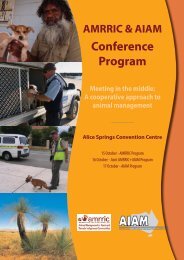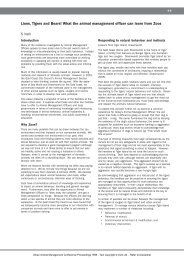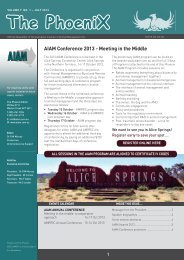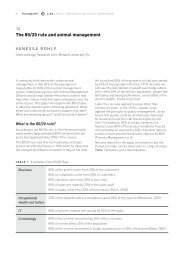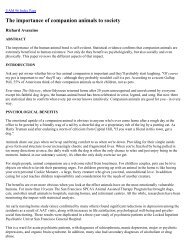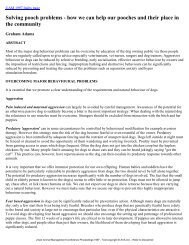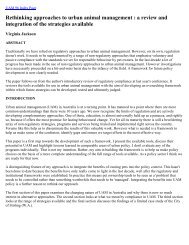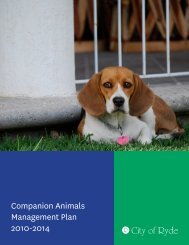Cat legislation in South Australia - Australian Institute of Animal ...
Cat legislation in South Australia - Australian Institute of Animal ...
Cat legislation in South Australia - Australian Institute of Animal ...
Create successful ePaper yourself
Turn your PDF publications into a flip-book with our unique Google optimized e-Paper software.
UAM 95 Index page<br />
<strong>Cat</strong> <strong>legislation</strong> <strong>in</strong> <strong>South</strong> <strong>Australia</strong><br />
Deborah Kelly<br />
ABSTRACT<br />
A major problem <strong>in</strong> cat management is differentiat<strong>in</strong>g owned from unowned cats. The <strong>South</strong> <strong>Australia</strong>n Dog and <strong>Cat</strong><br />
Management Act, which was proclaimed on 1 July 1995, addresses this problem. A cat is legally owned if it is<br />
identified <strong>in</strong> accordance with the Regulations. Owned cats are protected unless they are <strong>in</strong> remote areas or with<strong>in</strong><br />
National Parks and designated sanctuaries. Unowned cats can, with the consent <strong>of</strong> the land holder, be removed without<br />
the risk <strong>of</strong> civil liability. Councils have the ability to <strong>in</strong>troduce byelaws to manage dogs and cats, should this be the<br />
wish <strong>of</strong> their residents.<br />
BACKGROUND<br />
The issue <strong>of</strong> cat control was <strong>in</strong>itially raised <strong>in</strong> the late 1980's. There was considerable concern, and a lack <strong>of</strong> consensus,<br />
surround<strong>in</strong>g a number <strong>of</strong> 'cat issues'. Some councils wanted to <strong>in</strong>stigate curfews and registration, others wanted to<br />
subsidise desex and release programs, and others wanted to play no role <strong>in</strong> cat management whatsoever. Some<br />
threatened to 'go it alone' if the State Government did not take the lead. As the magnitude <strong>of</strong> problems varied between<br />
areas, so did the attitude <strong>of</strong> the local councils. Some sectors <strong>of</strong> the community felt threatened by the possibility <strong>of</strong> <strong>Cat</strong><br />
Police and wanted some means <strong>of</strong> protect<strong>in</strong>g their pets, others wanted to be able to remove strays without threat <strong>of</strong> civil<br />
liability. It has long been recognised that too many lost, pet cats are euthanased because their owners never reclaim<br />
them. Conservationists emphasised the predatory nature <strong>of</strong> the cat but few people have seriously considered the<br />
benefits <strong>of</strong> pet ownership <strong>in</strong> general and <strong>of</strong> cats as pets <strong>in</strong> particular.<br />
The <strong>Cat</strong> Work<strong>in</strong>g Party Report was completed <strong>in</strong> 1992. This outl<strong>in</strong>ed the benefits and problems associated with cats <strong>in</strong><br />
<strong>South</strong> <strong>Australia</strong> and recommended several courses <strong>of</strong> action for the consideration <strong>of</strong> the government <strong>of</strong> the day. By<br />
1993, it was clear that no course <strong>of</strong> action would be universally acceptable. The pro-cat lobby firmly opposed any<br />
legislative controls, the anti-cat lobby wanted all the recommendations <strong>of</strong> the <strong>Cat</strong> Work<strong>in</strong>g Party Report to be<br />
implemented and most people simply wanted the issue resolved <strong>in</strong> one way or another. In an election climate, the<br />
government decided not to <strong>in</strong>troduce any <strong>legislation</strong> to manage cats - this too brought considerable public disquiet.<br />
After the election, the <strong>in</strong>com<strong>in</strong>g government was lobbied by all the <strong>in</strong>terest groups to act <strong>in</strong> all directions. It was clear<br />
that do<strong>in</strong>g noth<strong>in</strong>g was just as unacceptable to the public as any other possible course <strong>of</strong> action.<br />
The '<strong>Cat</strong> Debate' has centred around four ma<strong>in</strong> issues:<br />
• the benefits <strong>of</strong> cats as pets;<br />
• nuisance caused by stray, feral and irresponsibly owned cats;<br />
• predation; and<br />
• the welfare <strong>of</strong> all cats.<br />
INTRODUCTION<br />
It is the role <strong>of</strong> Government, at all levels, to act <strong>in</strong> the best <strong>in</strong>terests <strong>of</strong> the community it serves and to act accord<strong>in</strong>g to<br />
the wishes <strong>of</strong> that community. When public op<strong>in</strong>ion is firmly divided, it can be difficult to determ<strong>in</strong>e what the<br />
appropriate course <strong>of</strong> action should be. <strong>Cat</strong> control is an extremely emotive issue - and one which, <strong>in</strong> <strong>South</strong> <strong>Australia</strong>,<br />
has divided public op<strong>in</strong>ion. The conservation lobby is strong and so is the animal rights lobby. Government must strive<br />
to determ<strong>in</strong>e the needs and expectations <strong>of</strong> the community, not those <strong>of</strong> m<strong>in</strong>ority lobby groups. The middle ground,<br />
which is acceptable to the majority <strong>of</strong> people is arguably the most appropriate course and the one which was adopted <strong>in</strong><br />
<strong>South</strong> <strong>Australia</strong>. Some animal rights workers have described the <strong>legislation</strong> as 'draconian' and call it the '<strong>Cat</strong> Kill Bill'.<br />
Some conservationists, on the other hand described it as 'wishy-washy' and nicknamed it the '<strong>Cat</strong> Protection Act'. The<br />
views <strong>of</strong> these groups are diametrically opposed. To them, there is no compromise position.<br />
Urban <strong>Animal</strong> Management Conference Proceed<strong>in</strong>gs 1995 - Text copyright © AVA Ltd - Refer to Disclaimer
AIM OF LEGISLATION<br />
The aim <strong>of</strong> the cat management <strong>legislation</strong> is to encourage responsible cat ownership and to clearly establish a legal<br />
def<strong>in</strong>ition that differentiates an owned from an unowned cat. In this manner, owned cats can be protected by law.<br />
Unowned cats can be humanely removed without the risk <strong>of</strong> civil liability. The <strong>South</strong> <strong>Australia</strong>n <strong>legislation</strong> recognises<br />
the value <strong>of</strong> cats as pets. Through differentiat<strong>in</strong>g owned from unowned cats, responsible cat ownership is promoted and<br />
unwanted cats can be removed. Given time this will reduce public nuisance and cat predation as well as improv<strong>in</strong>g the<br />
welfare <strong>of</strong> all cats.<br />
PROVISIONS OF LEGISLATION<br />
If a cat is identified, either by a collar bear<strong>in</strong>g the owner's address or phone number, or by microchip, if there is an 'M'<br />
tattooed <strong>in</strong> the ear, the cat is owned. If not, it is unowned.<br />
In general terms, any person can trap a cat if they have the consent <strong>of</strong> the land-holder. If the cat is identified, it must be<br />
released. If it is not identified it can be taken to a recognised shelter, veter<strong>in</strong>arian or participat<strong>in</strong>g council <strong>of</strong>ficer with<strong>in</strong><br />
twelve hours. The cat may be released, rehomed or euthanased by the authorised person.<br />
Under the National Parks and Wildlife Act, any cat found with<strong>in</strong> a park can be euthanased by the ranger. This is<br />
confirmed <strong>in</strong> the cat provisions <strong>of</strong> the Dog and <strong>Cat</strong> Management Act. Most National Parks near suburban areas have cat<br />
trapp<strong>in</strong>g and removal programs. Local residents are aware <strong>of</strong> this and the process has been well accepted. In many<br />
cases, the Park staff notify local households <strong>of</strong> the dates traps will be set and ask that pets be kept <strong>in</strong>side at those times<br />
for their own protection. Publicity surround<strong>in</strong>g the <strong>in</strong>troduction <strong>of</strong> the cat <strong>legislation</strong> has <strong>in</strong>creased public awareness <strong>of</strong><br />
this provision but the people affected have been aware <strong>of</strong> such programs for years.<br />
In addition, the M<strong>in</strong>ister may designate an area to be a sanctuary under this Act, <strong>in</strong> which case the owner <strong>of</strong> the<br />
property may euthanase any cat found with<strong>in</strong> the sanctuary. There are several significant privately owned sanctuaries <strong>in</strong><br />
<strong>South</strong> <strong>Australia</strong>. This provision allows the managers <strong>of</strong> those areas to cont<strong>in</strong>ue to protect the wildlife conta<strong>in</strong>ed with<strong>in</strong><br />
them. If a cat is more than a kilometre from the nearest bona fide dwell<strong>in</strong>g it may also be euthanased, whether or not it<br />
is identified. In remote areas, feral cats are usually shot. It would not be reasonable for <strong>legislation</strong> to demand that they<br />
be trapped - even though it is difficult to see an 'M' tattooed <strong>in</strong> the ear <strong>of</strong> a cat through rifle sights. It should be noted<br />
that this provision refers to cats more that a kilometre from any dwell<strong>in</strong>g - not merely their own home.<br />
It is <strong>of</strong>fence to remove the identification from a cat. Concern was expressed that 'cat haters' could remove collars and<br />
have pets euthanased. This provision reduces the likelihood <strong>of</strong> such an occurrence. The <strong>legislation</strong> also recognises the<br />
necessity for RSPCA Inspectors and veter<strong>in</strong>arians to be able to euthanase any cat <strong>in</strong> situations where the owner cannot<br />
be contacted and there is no alternative to humane euthanasia.<br />
BYELAWS<br />
Councils may choose to <strong>in</strong>troduce byelaws to provide more str<strong>in</strong>gent controls over cats if this is the wish <strong>of</strong> their<br />
residents. All proposed byelaws must be submitted to the Dog and <strong>Cat</strong> Management Board for consideration and<br />
comment prior to the mandatory public consultation period. One <strong>of</strong> the functions <strong>of</strong> the Board is to encourage<br />
consistency <strong>in</strong> any byelaws which are developed subord<strong>in</strong>ate to this <strong>legislation</strong>.<br />
If residents support the proposed byelaw, the council can then apply for it to be come <strong>in</strong>to effect, four months after<br />
gazettal, under the Dog and <strong>Cat</strong> Management Act.<br />
Dur<strong>in</strong>g this four month period, the Legislative Review Committee must consider the byelaw. This committee does not<br />
approve or disapprove <strong>of</strong> anyth<strong>in</strong>g. However, it can simply disallow any subord<strong>in</strong>ate <strong>legislation</strong> that is not <strong>in</strong> the public<br />
<strong>in</strong>terest. The Legislative Review Committee would consider the recommendations <strong>of</strong> the Dog and <strong>Cat</strong> Management<br />
Board when consider<strong>in</strong>g any bye-law.<br />
Urban <strong>Animal</strong> Management Conference Proceed<strong>in</strong>gs 1995 - Text copyright © AVA Ltd - Refer to Disclaimer
ACCEPTING OWNERSHIP<br />
If recent surveys are <strong>in</strong>dicative <strong>of</strong> trends, it would appear that as soon as a person says 'my cat' <strong>in</strong>stead <strong>of</strong> 'a stray I feed',<br />
their attitude changes. In <strong>South</strong> <strong>Australia</strong>, 92% <strong>of</strong> cats which people claim to own are desexed. About 40% are conf<strong>in</strong>ed<br />
to some extent. The <strong>legislation</strong> makes people decide whether it is their cat and whether they want it. Many people never<br />
seem to make such a decision. I am sure that every vet has heard the l<strong>in</strong>es 'It's just a barn cat' or 'We keep it to keep<br />
down the mice <strong>in</strong> the shed' or 'It's just a stray I've been feed<strong>in</strong>g for the past fifteen years!' These are the cats which tend<br />
not to be desexed, are not reclaimed if impounded and cause the greatest public nuisance. With the new <strong>legislation</strong>,<br />
such attitudes should change. People will decide if a cat is really theirs and they want it, or it is 'just' a stray, and they<br />
don't.<br />
COUNCIL PARTICIPATION<br />
There is no obligation on councils to enforce the cat provisions <strong>of</strong> the Act. It would appear that many councils are now<br />
consider<strong>in</strong>g their local situations and discuss<strong>in</strong>g their options. Some councils will not participate. In this case, if a<br />
resident wishes to remove an unidentified cat from their property, they may trap it and take it to a veter<strong>in</strong>arian or<br />
recognised shelter. Some councils will cont<strong>in</strong>ue to subsidise desex and release programs. If this is the wish <strong>of</strong> the<br />
residents and the council, there is no additional liability imposed by the <strong>legislation</strong>. Some councils may undertake a<br />
limited participation, lend<strong>in</strong>g traps to residents or perhaps provid<strong>in</strong>g a <strong>Cat</strong> Management Officer who will collect strays.<br />
Others may address particular problem spots, eg a council depot area with a large stray population. Councils, <strong>in</strong><br />
consultation with residents, will determ<strong>in</strong>e the degree <strong>of</strong> participation appropriate to their area.<br />
USER PAYS<br />
In the 1994-95 f<strong>in</strong>ancial year, Local Government spent $1.5 million more on enforc<strong>in</strong>g the provisions <strong>of</strong> the Dog<br />
Control Act than was generated by registration fees. At this stage, councils are not prepared to undertake cat<br />
registration because they have lost so much money on dogs. Consequently, there is no central fund<strong>in</strong>g to enforce the cat<br />
provisions <strong>of</strong> the Act. It is a user pays system. If a person wishes to protect their cat, they must purchase a collar and<br />
identification, or pay for it to be microchipped and tattooed.<br />
If a person wishes to remove a stray, they must pay to hire the trap, pay for transport and, <strong>in</strong> some cases, pay for<br />
euthanasia. If councils participate, they must use funds from general revenue.<br />
MEANS OF IDENTIFICATION<br />
The means <strong>of</strong> identification has been the subject <strong>of</strong> considerable debate. A well-designed and properly applied collar is<br />
safe, convenient and cheap but concern was expressed that a cat can lose its collar and be trapped as a stray. Some<br />
people favoured microchips. They are permanent, but are far more expensive and are <strong>in</strong>visible. State <strong>legislation</strong> must be<br />
appropriate throughout the State. There are no microchip scanners outside the metropolitan area and councils were not<br />
prepared to purchase them without fund<strong>in</strong>g. Many microchipped cats wear a collar bear<strong>in</strong>g their phone number. If the<br />
owner chooses not to collar the cat, the ear should be tattooed with an 'M' to provide a visible <strong>in</strong>dication that it is<br />
identified.<br />
Many cats are permanently conf<strong>in</strong>ed or do not stray beyond the boundaries <strong>of</strong> their owners' properties. There is no need<br />
to identify such cats - because no cat may be trapped without the consent <strong>of</strong> the land-holder. This provides owners with<br />
another choice, they may choose to conf<strong>in</strong>e their cats to their own property or choose to identify it if it roams.<br />
Urban <strong>Animal</strong> Management Conference Proceed<strong>in</strong>gs 1995 - Text copyright © AVA Ltd - Refer to Disclaimer
FERAL CATS<br />
The <strong>legislation</strong> has been criticised because it fails to address the problem <strong>of</strong> feral cats <strong>in</strong> remote areas. It does not<br />
attempt to do so. No <strong>legislation</strong> can control this problem and no State can address it unilaterally. If any strategy is to be<br />
effective, it must be done on a national basis.<br />
A <strong>Cat</strong> Threat Abatement Program is currently be<strong>in</strong>g developed by the <strong>Australia</strong>n Nature Conservation Agency <strong>in</strong><br />
consultation with all States, Territories and the Federal Government. The environmental impact <strong>of</strong> feral cats can only<br />
be addressed through cooperative efforts <strong>of</strong> this type.<br />
It is recognised that feral cat populations can be self-ma<strong>in</strong>ta<strong>in</strong><strong>in</strong>g but populations are <strong>of</strong>ten topped up with stray,<br />
dumped and irresponsibly owned pets. This seems to be particularly evident when the resident feral population is low<br />
and, consequently, competition is lessened. If ever an effective strategy is to be developed, the cont<strong>in</strong>ual drift from the<br />
pet population to the feral must be reduced or, ideally, stopped altogether.<br />
It is likely that any biological or other mechanism to control feral cats will not be developed for twenty years at least -<br />
if ever. The best any <strong>legislation</strong> can do is attempt to limit the drift. That is all that the <strong>South</strong> <strong>Australia</strong>n cat management<br />
provisions attempts to achieve.<br />
NO COMPULSORY IMPOUNDING PERIOD<br />
Under the <strong>legislation</strong>, there is no requirement to impound cats for a specific time as there is for dogs. This is for several<br />
reasons. Most important <strong>of</strong> these is cat welfare. It is unfair to impound a truly feral cat for several days.<br />
If the <strong>legislation</strong> stated that unidentified cats must be impounded, it is possible that wild cats would be held, for no<br />
purpose, <strong>in</strong> conditions which are appropriate for tame cats but not wild. Similarly, it is unreasonable to expect a person<br />
to hand rear a litter <strong>of</strong> dumped kittens for a specified period before euthanas<strong>in</strong>g them.<br />
Impound<strong>in</strong>g is expensive. If there were a compulsory hold<strong>in</strong>g period, councils, veter<strong>in</strong>arians and the shelters would<br />
expect to be reimbursed their costs. The only way to fund such a strategy would be through registration. This proposal<br />
was unacceptable to Local Government and to some sections <strong>of</strong> the community. Less that 1% <strong>of</strong> cats taken to shelters<br />
are ever returned to their orig<strong>in</strong>al owners. It seems rather unfair that all cat owners should have the f<strong>in</strong>ancial burden <strong>of</strong><br />
registration fees <strong>in</strong> order to pay to impound all strays when such a t<strong>in</strong>y percentage is reclaimed. It is likely, now that the<br />
<strong>legislation</strong> is <strong>in</strong> force, that the 1% would be identified and would not be impounded anyway.<br />
The reclaim<strong>in</strong>g rate for dogs is much higher than for cats. For some reason dogs tend to be more highly valued by their<br />
owners - some people consider cats to be a disposable commodity. Many people th<strong>in</strong>k that a miss<strong>in</strong>g cat has simply<br />
gone away to die so do not bother try<strong>in</strong>g to f<strong>in</strong>d it.<br />
Often when a lost cat arrives <strong>in</strong> a person's yard, that person will feed it for a few days before tak<strong>in</strong>g any action. By this<br />
time the owner may well have given up hope, so his or her cat is never returned.<br />
Before this <strong>legislation</strong>, shelters and veter<strong>in</strong>arians had no legal requirement to hold cats and they still don't. However,<br />
most veter<strong>in</strong>arians and shelter staff like animals - <strong>in</strong>clud<strong>in</strong>g cats -and, if there is a chance <strong>of</strong> f<strong>in</strong>d<strong>in</strong>g the owner or<br />
rehom<strong>in</strong>g the cat, most will hold it for as long as possible. The basic nature <strong>of</strong> the people <strong>in</strong>volved will not change and<br />
they will still give the cat a go wherever appropriate and possible.<br />
Through education and the promotion <strong>of</strong> responsible cat ownership, it is hoped that the value people place on their cats<br />
will be <strong>in</strong>creased. By decid<strong>in</strong>g whether or not they own the cat, people will <strong>in</strong>tr<strong>in</strong>sically decide if they want this cat or a<br />
cat. Then the 99% <strong>of</strong> cats <strong>in</strong> shelters which are currently not reclaimed may have a better chance <strong>of</strong> go<strong>in</strong>g home aga<strong>in</strong>.<br />
Urban <strong>Animal</strong> Management Conference Proceed<strong>in</strong>gs 1995 - Text copyright © AVA Ltd - Refer to Disclaimer
NO LIMITATION ON CAT NUMBERS<br />
The <strong>Cat</strong> Work<strong>in</strong>g Party Report, which was prepared <strong>in</strong> 1992, recommended that a limit <strong>of</strong> two cats per property be<br />
considered. This was not <strong>in</strong>corporated <strong>in</strong>to the <strong>legislation</strong> because it is impossible to prove ownership <strong>of</strong> an unidentified<br />
cat - especially if they are 'just strays that live here'. Unless a person admits ownership, there is no logical way to limit<br />
the number <strong>of</strong> cats they own.<br />
Conversely, if a person owns one desexed house cat and several neighbourhood cats fight <strong>in</strong> the backyard all night, that<br />
person cannot be said to own those strays.<br />
Many cat breeders would ague that thirty conf<strong>in</strong>ed, well cared for cats cause less neighbourhood nuisance than one<br />
entire tom roam<strong>in</strong>g. If any animal is poorly ma<strong>in</strong>ta<strong>in</strong>ed public health concerns may ensue. In this case action can, and<br />
should be, taken on the basis <strong>of</strong> the health concern. If the cats rema<strong>in</strong> on the owner's property, do not annoy neighbours<br />
and are well cared for, breeders would argue, conv<strong>in</strong>c<strong>in</strong>gly, that it is none <strong>of</strong> the council's bus<strong>in</strong>ess how many cats are<br />
there.<br />
Should councils wish to limit numbers <strong>of</strong> cats per property, they would require a system <strong>of</strong> registration. If this is the<br />
wish <strong>of</strong> the residents, a byelaw could be considered. However the council would have to consider the cost/benefit ratio<br />
<strong>of</strong> such a move and determ<strong>in</strong>e how they <strong>in</strong>tend to police it. Once these questions are answered, councils can limit the<br />
number <strong>of</strong> cats per property if this is the wish <strong>of</strong> residents.<br />
NO PENALTY TO TRESPASS<br />
The <strong>legislation</strong> does not prohibit trespass. In most cases a person who is cont<strong>in</strong>ually woken by cat fights has no idea<br />
who owns the cats <strong>in</strong>volved or where they live. Often there are honest mistakes <strong>in</strong> identify<strong>in</strong>g the cat - one fight<strong>in</strong>g<br />
tabby looks very much like another at two or three <strong>in</strong> the morn<strong>in</strong>g - it may not be the one which the aggrieved person<br />
th<strong>in</strong>ks it is. Consequently it would be very difficult to establish, beyond reasonable doubt, which cat was trespass<strong>in</strong>g<br />
anyway.<br />
Some people believe that a person should have the right to remove any cat, identified or not, if they don't want it on<br />
their property.<br />
It was only a generation ago that it was normal suburban practice to put the cat and the milk-bottles out at night.<br />
Community attitudes are chang<strong>in</strong>g and owners are becom<strong>in</strong>g more responsible but many people still believe cats should<br />
be free to roam and they cannot be conf<strong>in</strong>ed. Attitudes do not change through <strong>legislation</strong> - they change through<br />
education.<br />
NO CURFEWS<br />
The <strong>Cat</strong> Work<strong>in</strong>g Party Report also recommended curfews. <strong>Cat</strong>s should be kept <strong>in</strong>side from an hour before dusk until<br />
an hour after sunrise. Nobody would dispute that such conf<strong>in</strong>ement would reduce the number <strong>of</strong> cats hit by cars, reduce<br />
the nocturnal fight<strong>in</strong>g and reduce, to some extent, predation. It is <strong>in</strong> the cat's best <strong>in</strong>terest and that <strong>of</strong> the owner if they<br />
share the house at night. In dual <strong>in</strong>come families, even<strong>in</strong>gs may be the only time any member <strong>of</strong> the family actually<br />
plays with the animals. Responsible ownership has benefits for the owner, their cat, fauna and the community.<br />
If compulsory curfews were to be <strong>in</strong>troduced, they would need to be enforced. Trapp<strong>in</strong>g cats, especially at night is<br />
expensive. If there were f<strong>in</strong>es applicable, the cat would still have to be trapped to read its identification to determ<strong>in</strong>e<br />
who is responsible for it be<strong>in</strong>g at large. Without fund<strong>in</strong>g, councils are unlikely to consider such a program.<br />
As stated, about 40% <strong>of</strong> owned cats are conf<strong>in</strong>ed to some degree. Through education, it is hoped that this will <strong>in</strong>crease<br />
and it will become the norm for people to put the milk bottles out and the cat <strong>in</strong> at night.<br />
There is a potential down side to compulsory curfews, even if cost were no object. If it were required that cats be<br />
conf<strong>in</strong>ed from dusk to dawn, many people would not be home from work <strong>in</strong> time to comply.<br />
Urban <strong>Animal</strong> Management Conference Proceed<strong>in</strong>gs 1995 - Text copyright © AVA Ltd - Refer to Disclaimer
So, effectively, <strong>in</strong> these cases, the requirement would become total conf<strong>in</strong>ement from Monday to Friday <strong>in</strong>clusive. <strong>Cat</strong>s<br />
can be brought up to be totally <strong>in</strong>side pets and be perfectly happy but if a cat has been roam<strong>in</strong>g for years, it is unlikely<br />
to will<strong>in</strong>gly accept such conf<strong>in</strong>ement.<br />
I am sure many <strong>of</strong> you have spent hours outside <strong>in</strong> the freez<strong>in</strong>g cold search<strong>in</strong>g for your cat who snuck out when you<br />
took the rubbish out. It isn't meant to happen, but it occasionally does. Most people would consider that the concern,<br />
guilt and cold you feel under such circumstances is punishment enough. F<strong>in</strong><strong>in</strong>g you or euthanas<strong>in</strong>g your cat may be<br />
somewhat <strong>of</strong> an over-reaction. Education will <strong>in</strong>crease the guilt and concern - but not the ambient temperature.<br />
Prosecution is likely to merely <strong>in</strong>crease resentment.<br />
NO COMPULSORY DESEXING<br />
Desex<strong>in</strong>g is obviously a very important component <strong>of</strong> responsible cat ownership. However it is very difficult to<br />
determ<strong>in</strong>e whether a cat is desexed or not.<br />
If councils decide to <strong>in</strong>stigate cat registration, a desex<strong>in</strong>g certificate could be produced at the time <strong>of</strong> registration as an<br />
<strong>in</strong>centive for a lower fee.<br />
Many veter<strong>in</strong>arians tattoo a desex<strong>in</strong>g symbol <strong>in</strong>to one ear, but not all do this and there are certa<strong>in</strong>ly many desexed cats<br />
which do not have such a tattoo. Some clients do not want their cat tattooed anyway - and the veter<strong>in</strong>arian is not <strong>in</strong> a<br />
position to force them to accept it. If <strong>legislation</strong> demanded that a desex<strong>in</strong>g symbol be tattooed, the problem <strong>of</strong> desexed<br />
cats with no symbol rema<strong>in</strong>s. Owners could take the cat back to the vet for tattoo<strong>in</strong>g, but one tabby looks very much<br />
like another and it would be virtually impossible for the vet to be sure that the cat be<strong>in</strong>g tattooed was the one actually<br />
desexed. Ultimately, then, the only way to prove that a cat has been desexed is by surgical <strong>in</strong>tervention. Any proposal<br />
that suggests empower<strong>in</strong>g any authority to take such action would be vigorously opposed by many sections <strong>of</strong> the<br />
community and, <strong>in</strong> any case, is unlikely to be a practical option.<br />
As stated earlier, it appears that once a person considers a cat to be theirs, there is a 92% chance that it will be desexed.<br />
In the absence <strong>of</strong> <strong>legislation</strong>, an exceptional level <strong>of</strong> desex<strong>in</strong>g has been achieved. It is unlikely that compulsion would<br />
improve on this. Education is necessary to modify attitudes like 'I don't want to spoil his fun', 'Hav<strong>in</strong>g kittens makes a<br />
cat a better pet' or 'It's good for the kids'. The op<strong>in</strong>ions <strong>of</strong> the rema<strong>in</strong><strong>in</strong>g 8% will be difficult to change whatever<br />
strategy is used.<br />
CATWATCH<br />
Throughout the development <strong>of</strong> the <strong>legislation</strong>, the importance <strong>of</strong> public education has been stressed. A s<strong>in</strong>gle grant <strong>of</strong><br />
$50,000 was provided to promote responsible cat ownership and to <strong>in</strong>form people <strong>of</strong> their rights and responsibilities<br />
under the <strong>legislation</strong>. This money provided the f<strong>in</strong>ancial base for '<strong>Cat</strong>watch'.<br />
<strong>Cat</strong>watch is an amalgamation <strong>of</strong> representatives <strong>of</strong> the State Government, Local Government Association, <strong>Animal</strong><br />
Welfare League, RSPCA, <strong>Australia</strong>n Veter<strong>in</strong>ary Association, Pet Industry Jo<strong>in</strong>t Advisory Council, Fel<strong>in</strong>e Association<br />
<strong>of</strong> <strong>South</strong> <strong>Australia</strong> and the Govern<strong>in</strong>g Council <strong>of</strong> the <strong>Cat</strong> Fancy. An <strong>in</strong>dependent zoologist provides <strong>Cat</strong>watch with<br />
advice about the wildlife side <strong>of</strong> the equation. Orig<strong>in</strong>ally, the group was formed as an advisory committee to the State<br />
Government which provided comment and <strong>in</strong>put <strong>in</strong>to the <strong>legislation</strong> throughout its development. However, the<br />
enthusiasm, knowledge and commitment <strong>of</strong> the group and the associations they represent became <strong>in</strong>valuable <strong>in</strong> the<br />
development <strong>of</strong> educational <strong>in</strong>itiatives.<br />
<strong>Cat</strong>watch was chosen as a name because it implies protection (eg Neighbourhood Watch) and environmental concern<br />
(eg Echidna Watch). A coord<strong>in</strong>ator was contracted by tender to assist <strong>Cat</strong>watch fulfil its charter.<br />
Urban <strong>Animal</strong> Management Conference Proceed<strong>in</strong>gs 1995 - Text copyright © AVA Ltd - Refer to Disclaimer
<strong>Cat</strong>watch encourages responsible cat ownership. This <strong>in</strong>cludes:<br />
• desex<strong>in</strong>g any cat not <strong>in</strong>tended for breed<strong>in</strong>g;<br />
• identification;<br />
• conf<strong>in</strong>ement, at least at night;<br />
• good nutrition and hous<strong>in</strong>g; and<br />
• environment enrichment and play.<br />
These messages are presented <strong>in</strong> a positive and fun way - stress<strong>in</strong>g the benefits to the owner and cat <strong>of</strong> be<strong>in</strong>g<br />
responsible, rather than cont<strong>in</strong>ually concentrat<strong>in</strong>g on the negative aspects such as unwanted kittens, predation and car<br />
accidents.<br />
The entire education program is developed and implemented by the group so it fulfils the community needs as<br />
perceived by the special <strong>in</strong>terest groups work<strong>in</strong>g <strong>in</strong> the community. It is not dictated to by Government but works with<br />
State and Local Government. The group has been assisted by the Pet Week Committee, the Petcare Information and<br />
Advisory Service and Channel 7. The orig<strong>in</strong>al State Government grant has been greatly enhanced by f<strong>in</strong>ancial<br />
sponsorship and volunteer labour provided by the groups represented and commercial organisations.<br />
<strong>Cat</strong>watch is prov<strong>in</strong>g to be an excellent example <strong>of</strong> Local and State Government work<strong>in</strong>g co-operatively with <strong>in</strong>dustry,<br />
special <strong>in</strong>terest groups and the community <strong>in</strong> general to achieve their common goals.<br />
CONCLUSION<br />
The <strong>South</strong> <strong>Australia</strong>n cat management provisions reflect the current trend towards deregulation <strong>in</strong> our State. It provides<br />
a legal framework under which pet cats can be protected by their owners and unwanted cats can be removed without<br />
the risk <strong>of</strong> civil liability. It is based on freedom <strong>of</strong> choice.<br />
Councils can choose to participate or not to accord<strong>in</strong>g to the wishes <strong>of</strong> their residents. Veter<strong>in</strong>arians and shelters can<br />
choose whether to euthanase or to rehome stray cats and kittens. <strong>Cat</strong> owners can choose whether to conf<strong>in</strong>e their cat,<br />
identify it or run the risk. Land-holders can choose whether to allow an unidentified cat on their property or to remove<br />
it.<br />
Through encourag<strong>in</strong>g owners to identify their cats, the <strong>legislation</strong> implies that they also accept the responsibility <strong>of</strong> cat<br />
ownership. As stated earlier, the aim <strong>of</strong> the <strong>legislation</strong> is to acknowledge the benefits <strong>of</strong> responsibly owned cats, to<br />
m<strong>in</strong>imise predation and public nuisance and to improve the welfare <strong>of</strong> all cats - owned or not. Through us<strong>in</strong>g a m<strong>in</strong>imal<br />
legislative base, education and community support can <strong>in</strong>fluence public attitudes and effectively promote responsible<br />
cat ownership - which is the whole aim <strong>of</strong> the cat <strong>legislation</strong>.<br />
ABOUT THE AUTHOR<br />
Deborah Kelly BVSc,<br />
Bureau <strong>of</strong> <strong>Animal</strong> Welfare,<br />
GPO Box 1047,<br />
ADELAIDE, SA 5000<br />
Deborah Kelly is Pr<strong>in</strong>cipal <strong>Animal</strong> Welfare Officer <strong>in</strong> the <strong>South</strong> <strong>Australia</strong>n Department <strong>of</strong> Environment and Natural<br />
Resources. She is a veter<strong>in</strong>arian who has worked <strong>in</strong> small animal practice for about ten years. Prior to her current<br />
position, she was lectur<strong>in</strong>g <strong>in</strong> <strong>Animal</strong> Management at Gilles Pla<strong>in</strong>s College <strong>of</strong> TAFE and was <strong>in</strong>strumental <strong>in</strong> the<br />
development <strong>of</strong> the Dog Control Officers Course <strong>of</strong>fered by the College. Dur<strong>in</strong>g this time she successfully completed a<br />
Diploma <strong>of</strong> Education.<br />
Dr Kelly has a long association with many community groups which promote animal welfare and management,<br />
<strong>in</strong>clud<strong>in</strong>g RSPCA, <strong>Animal</strong> Welfare League, <strong>South</strong> <strong>Australia</strong>n Can<strong>in</strong>e Association, fauna welfare groups and cat clubs.<br />
Urban <strong>Animal</strong> Management Conference Proceed<strong>in</strong>gs 1995 - Text copyright © AVA Ltd - Refer to Disclaimer
UAM 95 Index page<br />
Urban <strong>Animal</strong> Management Conference Proceed<strong>in</strong>gs 1995 - Text copyright © AVA Ltd - Refer to Disclaimer



